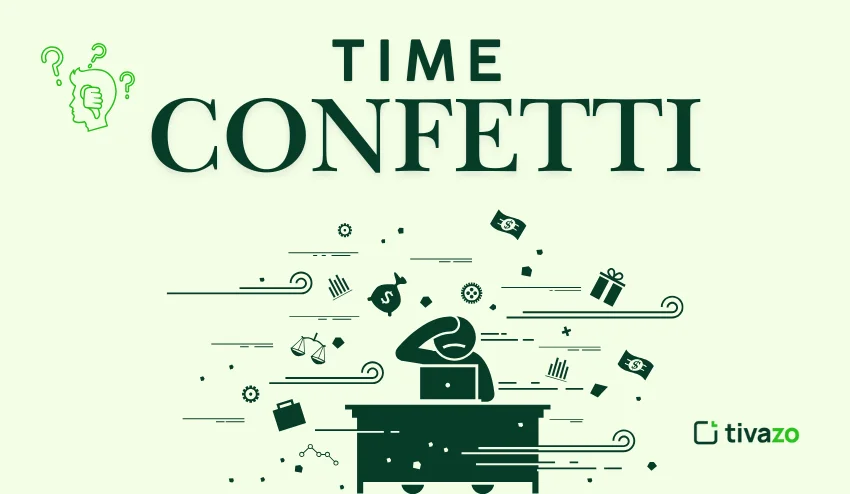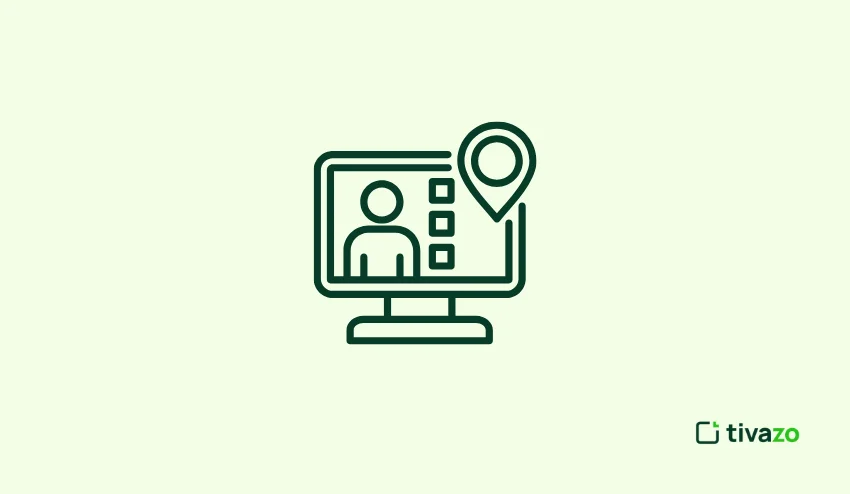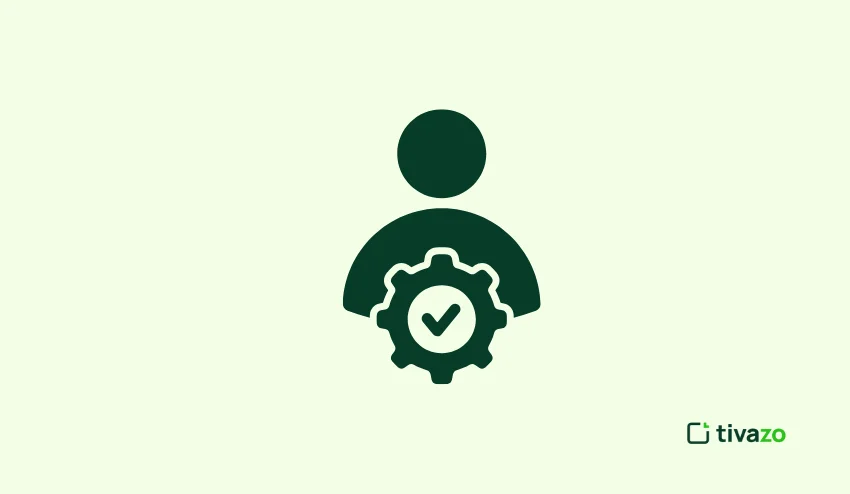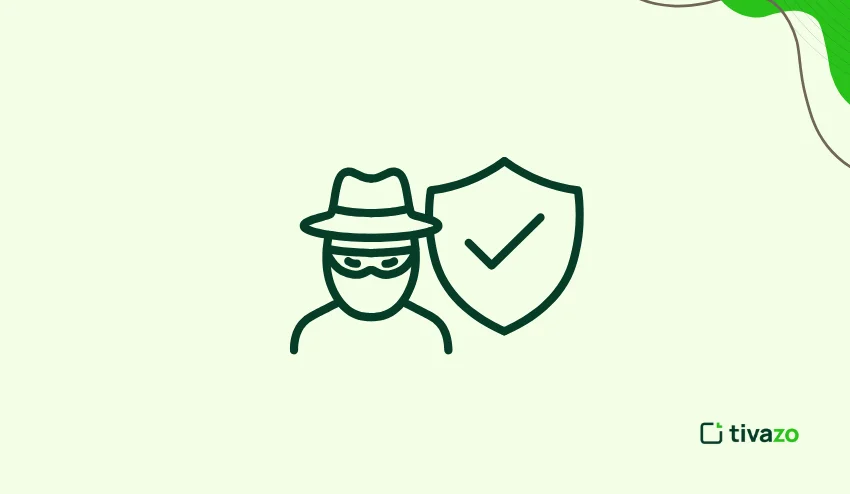Have you ever left work one day feeling busy, but unproductive? You opened messages, attended meetings, answered messages, and knocked out a couple of quick tasks-funds were just not put toward the most important things in a meaningful way. A feeling that not only defeats the productivity purpose of work but is actually taking place quietly is called time confetti.
In a world of constant connection, our appointments, research, thinking, and working are now broken into multiple-hour blocks. time confetti, and thus our ability to focus, think, and create valuable work is thwarted. Before we begin to talk about what to do have time confetti, it is important to explain what time confetti is and how it became a quiet productivity thief in the first place.
What is Time Confetti?
Our attention is pulled in so many directions: buzzing notifications, constant emails, unplanned meetings, “just a minute” requests, lists of “to-dos.” All of these quickly add up, and the interruptions in your day are incomprehensible. These common interruptions feel small, but combined, they add up to a destroyer of focus, attention, and productivity.
Time confetti is the source of this challenge. Just as confetti spreads everywhere at a party, your days get mined and spread out in time confetti, too. Over time, these moments build up, and you end up distracted, out of focus, and stuck with little ability to make progress on the things you care about most.
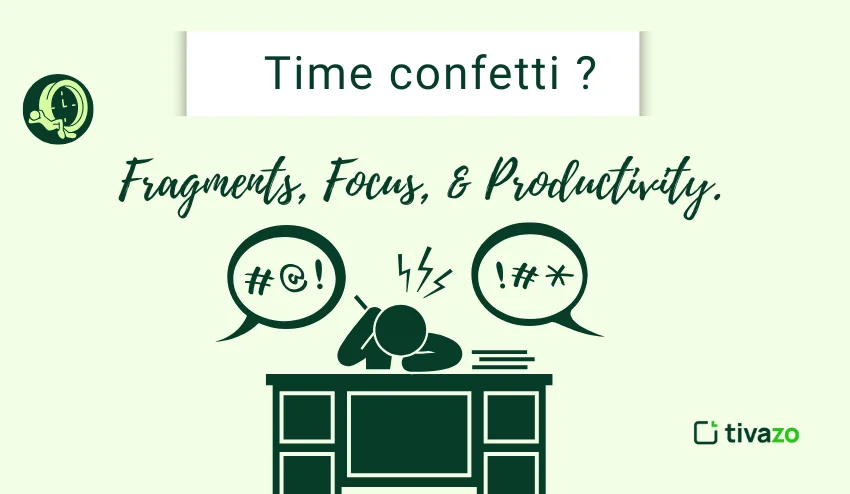
The Deterioration of Daily Productivity from Time Confetti
The cumulative impact of time confetti isn’t “just” a few minutes here and there—It chips away at your productivity, energy, and mental clarity, creating a noteworthy cumulative impact over time. It may not seem significant, but these small interruptions can add up to some serious dampeners, which is why you need to understand how:
1. Loss of Deep Focus
Distractions pull you out of a “flow state.” Once disrupted, it takes 20–30 minutes to regain your level of focus after one interruption.
2. Erroneous Work
Instead of focusing on one task at a time, the fragmented nature of your work extends your timelines and results in mistakes and errors.
3. Mental Fatigue
Context-switching drains cognitive energy. As a result, even if you’ve done little productive work through the day, your brain is fried.
4. Increased Stress Levels
The need to manage the many tiny interruptions creates feelings of overwhelm that can lead to burnout.
5. Poorer Work
With attention all over the place, creativity and your capacity for problem-solving suffer, leading to objectionable and almost meaningless work.
Common Breaks in Time in Remote or Hybrid Work Settings
1. Frequent Notifications
Pings from emails, messages, and social media are constant distractions, taking focus away from meaningful work! Even looking at notifications creates attention residue that goes away long after looking at it!
2. Multitasking
While multitasking appears to represent efficiency, in reality, it is fragmented attention across tasks where we take on cognitive load. What we see as productivity is really just shallow levels of engagement with several tasks that lead to more mistakes, slower progress, and greater dissatisfaction.
3. Unsought Meetings
When there are calls or video conferences scheduled on short or no notice that interrupt work that is planned and patterns of focus to create structure. Unsought meetings break the flow and induce task-switching anxiety in our staff, as people have to reset their minds after each meeting.
4. Home Distractions
For hybrid arrangements – chores, moving noise, or family interruptions fragment time, which makes momentum difficult.
These interruptions can spread precious hours across workdays and leave staff feeling busy rather than productive.
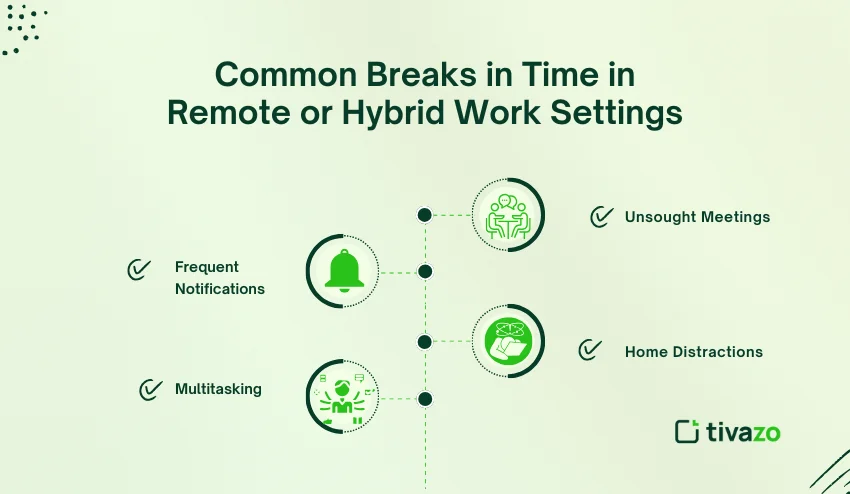
How Much Time Does an Average Employee Waste in Minor Interruptions daily?
Research shows that an average desk worker changes desktop applications every six minutes. This not only breaks apart deep work – it can result in “attention residue,” or what we might think of as our mind still partially focused on the previous task. In fact, studies indicate that it can take up to 23 minutes to fully refocus after an individual interruption. When aggregated across the landscape of a typical 8-hour workday, the “time confetti” starts to add up. Employees can feel “busy” – but much of that time is wasted on “recovering” versus progressing.
Interruptions can take their toll on productivity like this:
| Source of Distraction | Frequency (avg/day) | Time Lost for Each Event | Total Time Lost |
| Email & Messaging Pings | 50-60 | 1-2 minutes | ~1-2 hours |
| Application Switching | Every 6 minutes | 30-60 seconds | ~1 hour |
| Meetings (unscheduled) | 2-3 | 15-30 minutes | ~1 hour |
| Home/Environmental Distractions | 5-10 | 3-5 minutes | ~30-45 minutes |
On average, employees are losing 3-4 hours each day to mini interruptions – close to half the work day is distracted by time confetti.
How Multitasking Creates Fragmented Time
Although multitasking can feel like you’re getting things done, you’re actually spreading out your attention and limiting your brain’s higher functioning. Instead of making you more efficient, it only creates fragmented time that inhibits focus and productivity. Here’s what happens:
- Superficial Engagement: Multitasking causes your attention to be fractured, so you seldom give complete focus to any given activity, which ends up yielding more rushed or incomplete work.
- Loss of Deep Work: Deep work is a state of mind that requires sustained focus without interruption, and multitasking will never allow you to enter that level of concentration where you can problem-solve or be creative.
- Cognitive Switching Costs: When the brain diverts from one task to another, it uses additional calories for switching the brain’s attention back to the original. This detracts from mental resources and extends time in reaching created intended results (thinking time).
- Greater Mistakes: Multitasking creates divided attention, which leads to missing details, mistakes, and more time revisiting work that might have otherwise been completed correctly.
- Leading to a False Sense of Productivity: Often, multitasking can feel busy, but it often leads to initiating and not completing more tasks, giving you a false illusion of productivity but actually yielding less productivity.
In summary, multitasking really generates time confetti and spreads your day into useless segments.

Tactics for Minimizing Time Confetti
Minimizing time confetti effectively requires intentional tactics specifically designed to protect your focus while maximizing productivity. The following tactics are all achievable:
- Establish your boundaries: Be specific about your working hours and let your coordinated parties, coworkers, family, friends, etc., know. This will help to limit unexpected interruptions and keep people from disrupting your focus.
- Time blocks: Allocate time blocks to focused work and deliberately schedule work breaks. By assigning uninterrupted blocks to your high-priority tasks, you reduce task-switching and make significant progress without interruption.
- Turn off notifications: Deactivate any non-essential notifications associated with your emails, notifications from messaging apps, or social media, while you are working on deep work. Even the tiniest of notifications can break your focus and lead to wasted time.
- Batch your tasks. Ask yourself: Are there tasks that require a similar type of focus? Such as if you respond to your email at particular times of the day, or set aside time to do all of your admin work in the same sitting (called batching). Batching tasks reduces cognition-switching and will help you work more efficiently overall.
- Regular breaks: Short, defined work breaks allow your brain to recharge. Use a method such as the Pomodoro method, where you work 25 minutes, then take a 5-minute break. You can continue to use this method until you feel you need a longer break.
- Prioritization: Complete tasks that are most important or the most challenging, first thing in your day, when the degree of energy and focus are highest.
- Conscious Work Habits: Pay attention to distractions and intentionally bring your mind back to the task in front of you. When you do this, you are also strengthening your attention capacity, and the effect of time confetti will diminish over time.
By actively adopting these principles, employees can take back lost chunks of time, increase productivity, and lower stress levels.
How Do Teams Implement Tivazo Without Feeling Like They Are Being Miced?
Tivazo is a tool for employee monitoring and time tracking to help with productivity and efficiency. There are ways to roll out Tivazo on purpose, without discomfort or distrust.
- Transparent Communication– Be sure to communicate the clear purpose of Tivazo, to help with productivity, eliminate time confetti, and optimize workflows, NOT to micromanage your team.
- Opt-In features– You may always give team members the choice to opt in on features like task tracking, activity reports, or focus notifications. If you allow your employees to take the lead for these features, a sense of excitement can be created by the employee choosing the option, versus the employee feeling monitored by using it.
- Regular Feedback– Schedule recurring check-ins with your team, not to monitor their usage of Tivazo, but rather to get feedback on their experiences. You can monitor the settings or usage based on the feedback from your team, so it becomes a negative experience.
- Integrate It with Your Existing Workflow- You truly want to implement Tivazo to enhance existing workflows, not add more steps, so the adoption will be seamless and less intrusive.
By implementing Tivazo, with a focus on transparent communication, choice, and feedback, your team will be able to leverage the package to be tremendously productive while reducing disengagement and distrust.
How Can Managers Leverage Tivazo Data to Enhance Team Workflows?
Here’s the “Specific Metrics in Tivazo That Show Improvement Over Time” section in a table format:
| Metric | What It Measures | How It Shows Improvement |
| Time Spent on Tasks | Length of time taken for each task | Diminished wasted time is showing better focus and efficiency |
| Idle Time | Time spent not working or inactive periods | Diminished idle time is showing better engagement and workflow |
| Project Completion Rates | Percentage of tasks completed on time | Greater completion rates are showing better productivity and planning |
| Task Switching Frequency | The number of times employees switch between tasks | Less Frequency means less engaged time. |
| Focus Periods | Length of uninterrupted work blocks | Longer focus periods are showing improved time confetti reduction |
The table makes it easy for managers and teams to track performance trends and measure opportunities for continuous improvement, which reduces time confetti.
Does Tivazo have indicators that can gauge improvement over time?
Yes, Tivazo has several specific metrics that aid managers and teams specifically in measuring productivity trends over time, and provide areas to improve upon:
- Time on Tasks: This metric measures the time it takes for teams to complete their tasks from the start of the task to the finish. Managers are able to view trends over time can identify inefficient practices, and take action to streamline processes.
- Idle Time: This metric tracks when employees are inactive, completing tasks, allowing managers to figure out when employees are inactive as a result of being underutilized or being distracted. Reducing idle time leads to better productivity and focus.
- Project Completed Rates: Being able to monitor the percentage of tasks completed shows your team members‘ efficiency in getting their work completed on time.
- Task Switch Rates: Tivazo can also show the times that employees have switched from task to task and how that work is fragmented from “time confetti.”
- Focus Sessions: Having metrics to look at focused work sessions helps you measure improvements in deep work or sustained concentration over time.
By continuing to look at these metrics, your team can continually make informed decisions on how to fine-tune business processes to subsequently lessen the damage time confetti has on productivity.

Conclusion
Time confetti plagues the workday as notifications, multitasking, and interruptions tear apart employee focus and productivity. Small disruptions are costing employees what could add up to several working hours of productivity every day across every job.
To address this, you can utilize time blocking, resolving boundaries, limiting notifications, batching tasks, and time off for breaks, and using tools that aid in the reduction of wasted time. Tivazo is one such tool for collaboratively tracking work, optimizing workflows, and drastically shrinking waste.
By gaining insight into metrics like time working on tasks, time of idle time, time of completion of tasks, productivity time of projects and work, group time, and team time, managers will be able to ascertain and improve operational efficacy and help build a more focused working environment.
While helping to limit the time, confetti will help even further bring back lost time and productivity, and develop job outputs that matter.
